② 江苏省地理信息资源开发 与利用协同创新中心, 南京 210023;
③ 西安交通大学全球环境变化研究院, 西安 710049)
小冰期(Little Ice Age,简称LIA)是全新世最后一次北大西洋冰漂碎屑事件[1],也是距现代最近的全球性典型寒冷气候期,对人类社会的发展演变产生了重要的影响[2~4]。因此,小冰期时期不同区域气候变化特征及其动力学机制研究引起了学术界的广泛关注[5~7]。近十几年来,对过去气候变化的重建工作取得显著进展,初步揭示了近1000年中国气候变化的主要特征[8~12]。这些研究成果表明中国历史时期温度变化存在明显的百年尺度变率,可能存在着类似于欧洲的中世纪暖期(Medieval Warm Period,简称MWP)和小冰期(LIA)。宋元暖期(931~1320A.D.)与北半球存在的中世纪暖期(900~1300A.D.)基本对应,而明清冷期(1321~1920A.D.)与小冰期(1300~1900A.D.)相当。中国地区降水也存在明显的百年尺度变率[13~16]。甘肃万象洞石笋记录[9]与陇西地区干湿指数重建结果[17]显示中世纪暖期季风降水增加,以湿润气候为主;小冰期时期季风降水减少,以干旱气候为主。已有的研究表明中国区域百年尺度的温度变化大致一致,降水变化存在着显著的区域差异[18~21]。根据历史文献记载重建的过去2000年中国东部63个点(地区)旱涝等级数据,郑景云等[22]研究发现寒冷时段的旱涝格局呈自东向西带状分布,115°E以东涝、以西则旱涝相间;温暖时段则呈自南向北的带状分布,25°N以南地区旱、25°~30°N之间涝、30°N以北地区旱。Chen等[7]基于中国71个代用指标记录(包括历史文献、湖泊、石笋、树轮、冰芯等),分析发现中国北方季风区(30°N以北)中世纪暖期较小冰期湿润,而西部地区则相反,呈现东西差异模式;就东部季风区而言,中世纪暖期北方湿润而南方干旱,小冰期时期则相反,呈现南北差异模式。因此,受不同代用指标资料覆盖度、时空分辨率、年代学精度和气候意义解释存在差异等因素的限制,对于小冰期季风降水变化特征,包括干湿程度、内部结构、转型特征等仍然存在很大争议,需要更广泛空间的更多气候记录加以深入研究。
自Schwabe (1834)首次发现太阳活动周期以来,太阳活动与气候变化的联系便广受关注[23]。Bond等[1]证实了北大西洋全新世气候确实存在强烈波动,并与太阳活动密切相关,北大西洋温盐环流被认为是放大太阳活动信号并全球传输的重要载体;Tan等[8, 24]利用北京石花洞石笋纹层厚度重建了过去2650年北京地区暖季(5~8月)温度变化,发现与北高纬气候和太阳活动存在耦合关系;中国董哥洞石笋δ18O序列与树轮Δ 14C记录对比发现,二者在百年-十年尺度变化特征上高度相似,揭示了亚洲季风变化与太阳活动之间的密切联系[25],这一发现也得到了新建的太阳活动指标的进一步证实[26]; Zhang等[9]通过中国万象洞距今1810年以来的高分辨率石笋记录和太阳活动,中国(北半球)温度的对比研究,发现亚洲季风降水,太阳活动和中国温度之间存在着紧密的联系。因此,太阳活动通过北大西洋环流变化和/或北半球温度变化,影响亚洲季风区海陆热力差异或热带辐合带(Intertropical Convergence Zone,简称ITCZ)位置的迁移,进而影响亚洲季风降水变化。此外,厄尔尼诺-南方涛动(El Niño -Southern Oscillation,简称ENSO)也可能是太阳活动-气候变化联系的纽带[27, 28]。Asmerom等[29]通过美国西南部石笋记录研究发现太阳辐射增强时期对应于当地干旱事件,这种对应关系与亚洲季风-太阳之间联系相反,提出太阳辐射量变化可能通过赤道太平洋沃克环流、太平洋十年际涛动(Pacific Decadal Oscillation,简称PDO)以及ENSO等控制着低纬季风和美国西南部的气候变化。中世纪暖期持续偏正的北大西洋涛动(North Atlantic Oscillation,简称NAO)[30]也被认为与长期盛行类拉尼娜态有关,并可能受控于太阳辐射能量的增强[31~34]。大气遥相关机制则可能进一步将NAO、ENSO与亚洲季风降水相联系[35]。最新的研究成果指出,虽然太阳辐射变化可能是影响小冰期气候变化的主要因素,但是火山爆发和大气CO2浓度的降低也可能导致小冰期时段副极地环流减弱和显著降温现象,进而影响亚洲季风变化[36~39]。因此,目前小冰期时期十年际尺度季风降水变化的动力学机制仍不明确。万象洞石笋记录与太阳活动记录的对比发现,小冰期期间发生的两次弱季风事件(元朝晚期和明朝晚期),均对应于强太阳辐射时期[9]。董哥洞石笋记录显示Spñrer太阳黑子极小期(1450~1550A.D.)对应于亚洲季风的增强时期,而亚洲夏季风(Asian Summer Monsoon,简称ASM)与南美夏季风(South American Summer Monsoon,简称SASM)在十年-百年尺度上的反相位关系则暗示亚洲季风变化可能与ENSO有关[16]。Berkelhamme等[40]研究印度Dandak洞石笋δ18O记录发现,数十年尺度印度季风降水变化与太阳辐射通量在中世纪暖期(MWP)具有良好的对应关系,而在小冰期这种对应关系减弱,因此认为北大西洋海表温变化可能是季风降水变化的主要驱动因素。因此,小冰期时期亚洲季风变化过程及其驱动机制尚存争议,仍需大量具有高精度年代控制的高分辨率地质记录加以研究。这里,我们采集亚洲季风区四川黑竹沟洞一支石笋(编号:EB1),通过高精度230Th定年和高分辨率同位素数据分析,重建小冰期时期亚洲夏季风变化历史,探索小冰期亚洲季风演变过程(转型特征、振荡频率以及变化幅度),进而探讨其成因机制。
2 材料与方法 2.1 区域概况黑竹沟洞(28°56′02″N,103°05′47″E;海拔1400m)(图 1),位于四川省乐山市峨边县哈曲乡巴溪村,属小凉山区。洞穴封闭性较好,洞内年均温度约为16℃,相对湿度约100 %。黑竹沟洞在地理位置上处于青藏高原东部,四川盆地西南部。由于四川盆地位于高原大地形与中国东部平原的过渡区,所以这一特殊的地理位置使得研究区气候既受东亚季风和印度季风的影响,同时又受青藏高原大气环流系统的影响[41]。研究区年平均降水量为700~1200mm,随着海拔的上升,降水不断增加且年际降水变化幅度较大,年际变化率在16 %~23 %左右。本区全年夏季降水最多,集中在6、7、8月份,占全年降水量的50 %~60 %,属于亚热带湿润季风气候[42]。
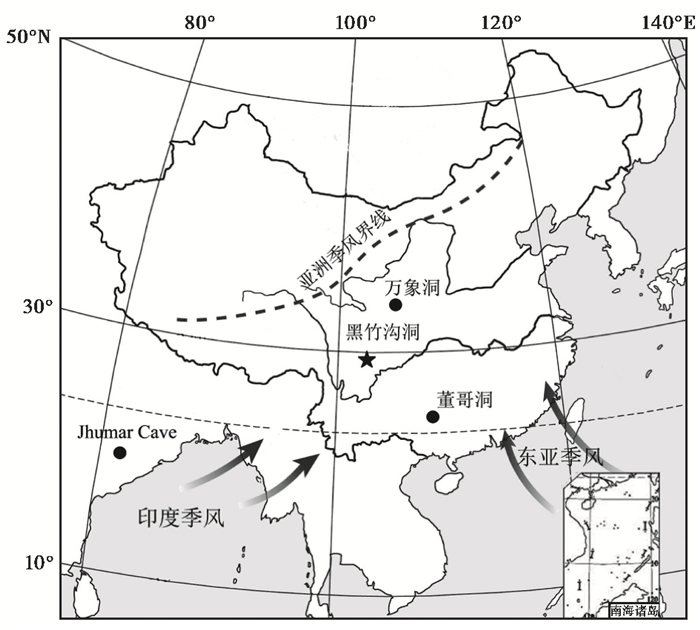
|
图 1 四川黑竹沟洞及相关洞穴所在位置 黑色圆点代表万象洞、董哥洞和Jhumar洞所在位置;黑色五角星代表黑竹沟洞所在位置 Fig. 1 Locations of Heizhugou Cave in Sichuan and other relative caves. Black dots represent the locations of Wanxiang, Dongge and Jhumar caves respectively; Black star represents the location of Heizhugou Cave |
石笋EB1总长160mm,采集于距洞口约30m处的洞厅,洞口宽约1m,高约2m,洞穴封闭状况良好,洞顶滴水持续而稳定。沿生长轴切开抛光后观察发现,石笋由纯净透明的方解石组成,无重结晶现象。通过石笋纹层特征可以将该石笋分成两段:1)0~110mm呈长柱状,直径约50~65mm;2)110~160mm呈短柱状,直径约65~80mm。尽管在深度110mm处该石笋生长轴心发生了偏移,但岩性没有明显变化。而测年结果表明此处石笋生长速率基本稳定,与整段石笋基本一致,进一步证实整根石笋在该段不存在沉积间断(图 2)。

|
图 2 黑竹沟洞石笋EB1抛光面照片 黑点表示同位素采样点;红点表示“Hendy test”[44]采样点 Fig. 2 Polished surface of the sample EB1 from Heizhugou Cave. Black dots represent isotope sampling points; Red dots represent sampling points of "Hendy test"[44] |
沿石笋生长轴,用直径0.9mm的牙钻分别从距顶1mm、8mm、20mm、40mm、58mm、80mm、100mm、120mm和140mm处钻取了9个铀系年代样,采样宽度约1mm,分析仪器为MC-ICP-MS Neptune型电离质谱仪,化学实验方法参照Shen等[43],由西安交通大学全球环境变化研究院完成,年龄误差为±2σ(表 1)。用直径0.3mm的牙钻沿石笋生长中心轴每间隔1mm取样,共获取160组氧碳同位素样品。利用碳酸盐自动进样装置以及Finnigan MAT -253型质谱仪联机完成测试,每9个样品插1个标准样品(NBS-19),分析误差小于±0.06 ‰,VPDB标准,由南京师范大学地理科学学院同位素质谱实验室测试完成。
| 表 1 黑竹沟洞EB1石笋230Th测年结果* Table 1 230Th dating results of the stalagmite EB1 from Heizhugou Cave |
表 1给出EB1石笋9个样品的U/Th同位素组分和230Th年龄。样品238U含量较高,在2883±10~3599±12ppb之间,232Th含量则相对较低,在106±4~444±9ppt之间,测年误差在5~9a之间,仅有一个年龄误差超过10a。年龄结果显示,在距顶0~140mm层段,该石笋覆盖了140~500a B.P.(即1450~1810A.D.)。年龄与深度曲线(图 3)表明石笋沉积速率较稳定,平均生长速率在0.4mm/a左右。本文在0~140mm层段采用相邻测年点间线性内插法,在140~160mm层段采用外推法,获得每个氧同位素的年龄,从而建立EB1石笋140~575a B.P.时段(即1375~1810A.D.)平均分辨率约为3a的时间序列(图 4)。

|
图 3 黑竹沟洞EB1石笋生长速率图 黑色圆点表示校正后的230Th测年结果;误差棒表示石笋记录的测年误差(±2σ) Fig. 3 Growth rate of stalagmite EB1 from Heizhugou Cave. Black dots represent corrected230Th dating results; Error bars indicate the range of age errors (±2σ) |
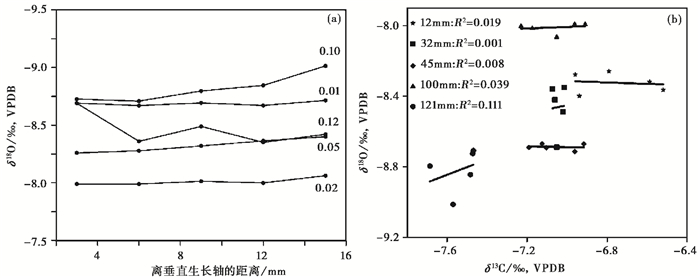
|
图 4 黑竹沟洞EB1石笋δ18O曲线 黑色曲线为EB1石笋5点平滑后的δ18O记录;横向虚线表示该时段δ18O平均值 Fig. 4 δ18Ovalues for the stalagmite EB1 from Heizhugou Cave. Black curve shows 5-point running mean of δ18O values from stalagmite EB1; The horizontal dashed line indicates the average value of δ18O in this period |
在石笋发育过程中,方解石与岩溶水之间同位素达到平衡是石笋δ18O作为古气候代用指标的前提条件[44]。根据Hendy检验准则[44],选取5个不同生长层,每个生长层沿纹层方向以3mm间距取5个样品进行同位素分析。分析结果显示石笋各层δ18O值变化基本一致,其相对标准差都落在0.01~0.12范围内(图 5a)。相关性分析显示,石笋同一生长层上δ18O与δ13C之间无显著相关性(图 5b)。上述检验结果表明,石笋EB1在整个生长段受动力分馏作用较小,接近同位素分馏平衡状态,适于古气候重建。
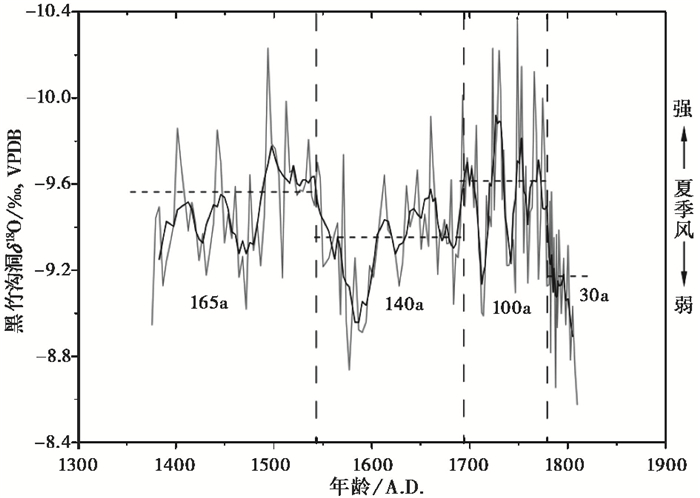
|
图 5 黑竹沟EB1石笋Hendy检验结果 Fig. 5 Results of "Hendy test" for the stalagmite EB1 from Heizhugou Cave |
目前,对亚洲季风区石笋氧同位素所指示的气候意义仍存在争议[18, 45~47]。主要有以下几种观点:1) 石笋δ18O表示夏/冬降水比率变化[48];2) 代指气团在热带印度洋-太平洋和洞穴地点之间运移过程中的水汽剩余比[49];3) 反映大气降水的变化,并且这一变化受控于亚洲季风强度[50, 51];4) 反映印度季风强度变化而非东亚季风降雨量水平[46];5) 环流效应假说认为δ18O主要反映远近水汽源份额的变化[52, 53]。尽管说法不一,但多数学者认为中国季风区石笋δ18O变化一般指示平均气候状态下的夏季风强度变化,即δ18O值偏正指示夏季风减弱,反之亦然[54~56]。
3.3 石笋δ18O记录EB1石笋氧同位素序列详细记录了我国四川盆地南部小冰期时期(1375~1810A.D.)气候变化信息(图 4)。石笋δ18O值在-10.37 ‰~-8.58 ‰范围内波动,平均值为-9.42 ‰。进一步观察可将序列大致分为4个时段:1375~1540A.D.,δ18O值偏负,平均值为-9.49 ‰,为亚洲夏季风增强时期;1540~1680A.D.,δ18O值偏正,在1600A.D.左右达到最正,约-8.73 ‰,平均值为-9.34 ‰,这一阶段为季风显著衰弱时期;1680~1780A.D.,δ18O值偏负,平均值为-9.54 ‰,为亚洲夏季风增强时期,并显示显著的高频振荡特征,变幅达约1.4 ‰;1780~1810A.D.,δ18O值从-10 ‰迅速偏正至-9 ‰,平均值为-9.08 ‰,季风强度再次减弱。
EB1石笋δ18O记录在整体变化过程上叠加了多次高频振荡旋回,振幅大部分超过0.6 ‰,显示明显的峰谷波动变化,反映一系列十年际尺度季风加强和减弱事件(图 4)。
4 讨论 4.1 小冰期季风气候区域对比对比四川黑竹沟洞、甘肃万象洞、贵州董哥洞和印度中部Jhumar洞石笋记录[9, 16, 57](图 6),发现其δ18O变化具有较好的相似性。在重叠时段整体变化过程大致相同,δ18O值均表现缓慢正偏而后逐步恢复(负偏)的过程,且在整体变化过程中均叠加了一系列次一级的高频振荡旋回,指示上述区域降水可能共同受控于印度季风水汽输送影响。现代气象观测数据研究发现四川盆地夏季降水主要受控于西南水汽输送,且与我国西北及华北地区降水呈显著正相关,因此可能反映了印度季风强度变化[42, 58]。在区域对比中,有两点值得关注:
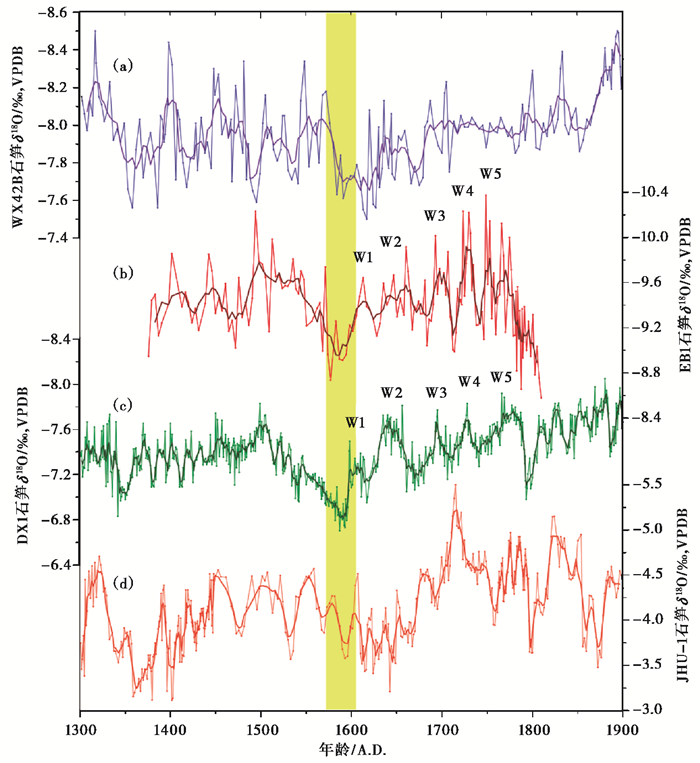
|
图 6
四川黑竹沟洞与甘肃武都万象洞[9]、贵州董哥洞[16]以及印度中部Jhumar洞[57]石笋δ18O记录的对比
(a) 甘肃武都万象洞WX42B石笋δ18O记录[9];(b) 四川黑竹沟洞EB1石笋δ18O记录; (c) 贵州董哥洞DX1石笋δ18O记录[16];(d)印度中部Jhumar洞JHU-1石笋δ18O记录[57] (a),(b),(c)和(d)曲线中颜色较深的曲线(即深紫、深红、深绿和深橘色曲线)为5点平滑后的石笋δ18O记录;黄色阴影部分指示明末弱季风事件;W1~W5分别为5个强季风振荡旋回 Fig. 6 Comparison of the stalagmite δ18O records from Wanxiang (purple curve), Heizhugou (red curve), Dongge (green curve) and Jhumar (orange curve) caves. (a)δ18O records for stalagmite WX42B of Wanxiang Cave in Gansu[9]; (b) δ18O records for stalagmite EB1 from Heizhugou Cave in Sichuan; (c) δ18O records for stalagmite DX1 of Dongge Cave in Guizhou[16]; (d) δ18O records for stalagmite JHU-1 of Jhumar Cave in Central India[57]. Darker curves (deep purple, deep red, deep green and deep orange curves) in (a), (b), (c) and (d) show 5-point running mean of stalagmite δ18O values; Yellow shadow indicates the Late Ming Weak Monsoon Period; W1~W5 represent five oscillation cycles of strong monsoon, respectively |
第一,高分辨率黑竹沟洞石笋记录在1600~1800A.D.之间,存在5个持续时间约40a,振幅约1 ‰的季风振荡旋回(见图 6b中W1~W5),这一变化过程得到董哥洞记录的支持(图 6c)[16]。每一个W事件又叠加了次一级高频振荡,进一步凸显了小冰期时期气候的不稳定性。黑竹沟洞δ18O记录在1780~1810A.D.表现显著的正偏过程,可能指示存在一次弱季风事件。这一事件在董哥洞石笋[16]、阿曼石笋[59]、印度石笋[57]、达索普冰芯[60]、亚洲树轮记录[61]中均有体现,可能与18世纪晚期的强厄尔尼诺事件有关[62]。
第二,黑竹沟洞石笋记录显示,从16世纪中期δ18O值快速正偏约1 ‰,16世纪晚期达到最正值,随后缓慢负偏,直到17世纪末恢复,指示一个明显的弱季风事件(图 4),这一事件在时间上大致对应于万象洞石笋记录[9]的“明末弱季风时期”(1580~1640A.D.,Late Ming Weak Monsoon Period,简称LMWMP)。董哥洞和印度中部石笋记录均体现了这一弱季风事件(图 6c和6d)。明朝末期属于小冰期极盛期,诸多信息载体显示这一时期极端干旱事件的频繁发生[63~67](比如史称“崇祯大旱”)。甘肃省东部黄爷洞石笋建立的过去1860年δ18O记录表明此次弱季风事件对应小冰期时期降水的急剧减少和温度骤降[66];刘禹等[64]通过青海都兰树轮研究记录指出1590~1700A.D.左右为近1000年青藏高原东北部降水量最少的阶段之一,当地呈严重干旱的气候特征;Cook等[61]利用树轮资料重建了过去700年亚洲季风区的帕尔默干旱指数(Palmer Drought Severity Index,简称PDSI),提出亚洲季风区1638~1641A.D.存在重大干旱事件,认为赤道附近海表温异常导致亚洲季风衰退;Shen等[65]利用过去500年中国地区干湿指数(Drought/Flood Index,简称DFI)序列证实明末干旱事件与小冰期其他干旱时段相比,虽然持续时间短,但其强度大,空间覆盖区域广,几乎覆盖了55 %的中国东部地区,是我国近500年来最为严重的干旱时期[61, 65]。目前,不少史料研究指出气候变化在社会演变进程中可能扮演着重要作用[3, 4, 68]。明末弱季风事件可能导致农业歉收、饥荒爆发、经济崩溃、农民起义增加等一系列社会动荡[9, 17, 66],在一定程度上可能加速了明朝灭亡(1644A.D.)。
当然,在细节对比上,4个洞穴记录也存在一定差异。比如,董哥洞和黑竹沟洞石笋记录中所显示的季风高频振荡特征在万象洞和印度中部石笋记录并不突出且频率并不一致。黑竹沟洞与印度中部石笋δ18O变幅较大,多数峰谷振幅介于1.0 ‰~1.5 ‰之间,最大振幅甚至接近2 ‰,而万象洞石笋δ18O变化振幅较小,多数峰谷振幅不超过1 ‰,转换过程相对平缓。这些差异的原因可能是多方面的:1) 不同洞穴岩溶系统及其上覆土壤层对大气降水δ18O信号的平滑作用是存在差异的,可能直接影响洞穴滴水和石笋δ18O值变化,从而记录不同程度的气候变化信号[69]。2) 不同区域对短尺度季风降水的响应可能存在差异。基于黑竹沟洞(宜宾和成都)、万象洞(武都)和董哥洞(河池和桂林)临近气象站点近50年来降水资料,统计分析表明3个区域全年和夏季降水存在一定差异。而处于季风边缘区的万象洞记录与局地降水的相关性最好(r=-0.64)[9],董哥洞与夏季风指数相关性较好(r=-0.42)[16],黑竹沟洞没有现代沉积进行对比分析。总体而言,上述洞穴记录可以在不同程度上反映亚洲夏季风降水变化特征,而黑竹沟洞和董哥洞石笋记录了相似的年代际尺度振荡特征,表明这些信号很有可能是真实可靠的。
4.2 成因机制分析 4.2.1 百年尺度季风变化成因已有研究表明,全新世亚洲季风变化与北高纬气候之间存在密切联系[25, 70]。本文将黑竹沟洞石笋δ18O记录与北半球温度序列[71]对比(图 7),从中可以看出:在1400~1550A.D.和1700~1800A.D.时期,北半球升温对应EB1石笋δ18O的负偏; 而在1550~1700A.D.,北半球降温则与石笋δ18O总体偏正相对应。这些对比结果证实亚洲季风强度与北半球气温在百年尺度上可能存在成因联系。作为全新世最后一次北大西洋冰漂碎屑事件[1],小冰期成因机制可能与其他冰漂碎屑事件(如8.2ka事件[72~74])类似,即高纬地区大量淡水快速注入北大西洋,引起海表水密度降低,使得北大西洋深层水(North Atlantic Deep Water,简称NADW)的形成受到抑制,从而削弱大西洋经向翻转流(Atlantic Meridional Overturning Circulation,简称AMOC),降低高低纬间的热量交换效率。当AMOC减弱时,从南大洋向北大西洋输运的暖水减少,更多的热量停留在南大洋,因此南半球变暖而北半球变冷[75, 76],进而导致ITCZ位置长期处于南半球[77],造成这一时期亚洲季风强度减弱。
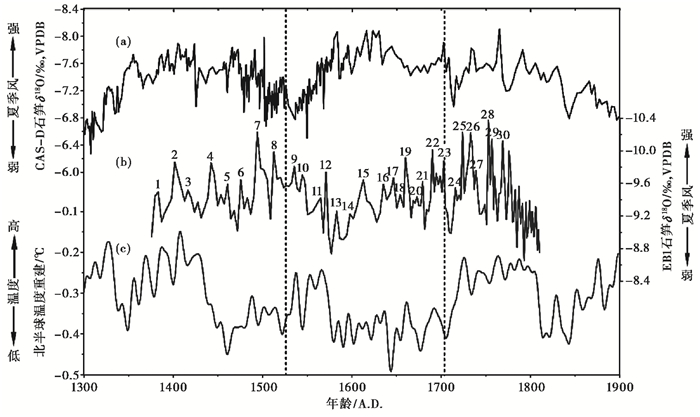
|
图 7 黑竹沟洞石笋δ18O记录与秘鲁石笋δ18O记录[78]、北半球温度记录[71]对比 (a) 秘鲁Cascayunga洞CAS-D石笋δ18O记录[78];(b) 四川黑竹沟洞EB1石笋δ18O记录(1~30分别代表 30个气候振荡旋回);(c) 北半球温度序列重建记录[71] Fig. 7 Comparison among the stalagmite δ18O values from Heizhugou Cave in Sichuan, Cascayunga Cave in Peru and northern temperature record. (a) δ18O records for stalagmite CAS-D of Cascayunga Cave in Peru[78]; (b) δ18O records for stalagmite EB1 of Heizhugou Cave in Sichuan (1~30 represent 30 oscillation cycles of climate, respectively); (c) Reconstruction of Northern Hemisphere temperature sequence[71] |
这里,我们进一步将黑竹沟洞石笋与南半球秘鲁Cascayunga洞石笋δ18O记录[78]对比,发现两者具有一定相似性,但呈反相位关系,即亚洲夏季风增强时期,南美夏季风处于减弱时期。南北半球季风环流变化的反相位关系,证实了ITCZ位置的南北移动是联系半球间气候变化的纽带,在半球间能量传递和交换过程中发挥着重要作用[77]。这些证据表明在百年尺度上北高纬气候(温度)信号可能通过AMOC与ITCZ相互耦合,从而影响全球季风变化。
4.2.2 十年尺度季风变化成因显著的十年际尺度振荡旋回是黑竹沟洞δ18O记录的重要特征。在石笋生长的约430年期间,肉眼可以识别出30个持续时间约10a的气候振荡旋回(图 7b)。进一步采用REDFIT37功率谱分析软件对EB1石笋的δ18O序列进行周期分析(图 8),结果显示存在约25a和约9a周期(通过90 %统计置信度检验),接近太阳活动的22a海尔周期和11a太阳黑子周期。上述结果表明太阳活动可能是小冰期时期高频季风振荡的重要驱动因子。
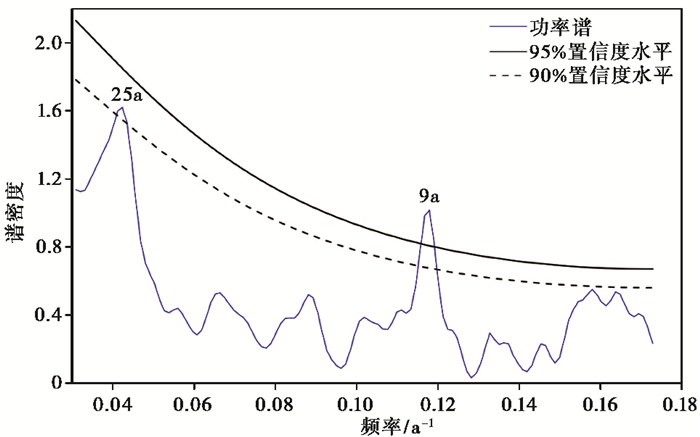
|
图 8 黑竹沟石笋δ18O功率谱分析结果 Fig. 8 Spectral analyses of the stalagmite EB1δ18O sequence from Heizhugou Cave |
过去的大量研究证实太阳活动与季风气候在全新世不同气候背景下的密切联系[25]。比如贵州衙门洞石笋研究中发现了早全新世存在约14a太阳活动周期[79]。Zhang等[9]基于甘肃省万象洞距今1810年以来的高分辨率石笋δ18O记录,与太阳活动指标(树轮Δ 14C以及10Be和14C重建的太阳辐射总量)对比研究发现两者具有很好的相关性,功率谱分析显示其具有约10.5a太阳黑子周期。黑竹沟洞高分辨率石笋记录进一步证实了小冰期时期季风变化与太阳活动之间的密切联系。Shindell等[80]通过GISS平流层环流模型分析揭示太阳黑子活动能够通过对臭氧层的影响,进而改变高低纬大气层之间的温度差和压力梯度,从而引起低纬季风环流强度的变化。
5 结论基于高精度铀系定年,平均分辨率约3a的四川黑竹沟洞EB1石笋记录揭示了小冰期时期(1375~1810A.D.)亚洲夏季风变化特征:1375~1540A.D.和1680~1780A.D.两个时段,δ18O偏负,指示亚洲夏季风增强;1540~1680A.D.和1780~1810A.D.时段,δ18O偏正,表明亚洲夏季风减弱。EB1石笋δ18O记录也呈现显著的十年际尺度高频振荡特征,振幅大部分超过0.6 ‰,峰谷波动明显。尤其在1600~1800A.D.之间,存在5个持续时间约40a、振幅约1 ‰的季风振荡旋回(W1~W5),与董哥洞石笋记录总体一致,揭示了小冰期时期气候的不稳定性。
黑竹沟洞高分辨率石笋记录显示在16世纪末存在一次明显的季风减弱事件,在时间上大致对应于“明末弱季风时期”(1580~1640A.D.,LMWMP),也成为我国近500年来最严重的特殊干旱期。此次弱季风事件得到万象洞、董哥洞、印度中部石笋记录以及树轮、历史文献记录的支持,证实了这一事件的普遍性和区域广泛性。1780~1810A.D.时段,石笋δ18O再一次表现显著的正偏过程,可能指示存在一次弱季风事件。这一事件在董哥洞石笋、阿曼石笋、印度石笋、达索普冰芯、亚洲树轮记录中均有体现,可能与18世纪晚期的强厄尔尼诺事件有关。
在百年尺度上,黑竹沟石笋δ18O记录和北半球温度记录同步变化,与自南半球秘鲁Cascayunga洞石笋δ18O记录呈反相位变化关系,说明在百年尺度上亚洲季风与北高纬气候存在快速响应关系,北高纬气候信号可能通过AMOC与ITCZ相互耦合,从而影响全球季风变化。石笋δ18O序列的功率谱分析结果显示约25a和约9a主导周期,大致对应于太阳黑子活动周期,表明小冰期短尺度季风变化的主控因子可能为太阳活动。
致谢: 感谢审稿专家和编辑部老师建设性的修改意见,使论文得以完善。
| 1 |
Bond G, Kromer B, Beer J, et al. Persistent solar influence on North Atlantic climate during the Holocene. Science,2001, 294 (5549) : 2130~2136.
doi:10.1126/science.1065680 ( 0) 0)
|
| 2 |
Weiss H, Bradley R S. What drives societal collapse?. Science,2001, 291 (5504) : 609~610.
doi:10.1126/science.1058775 ( 0) 0)
|
| 3 |
Yancheva G, Nowaczyk N R, Mingram J, et al. Influence of the intertropical convergence zone on the East Asian monsoon. Nature,2007, 445 (7123) : 74~77.
doi:10.1038/nature05431 ( 0) 0)
|
| 4 |
Liu Yu, An Zhisheng, Linderholm H W, et al. Annual temperatures during the last 2485 years in the mid-eastern Tibetan Plateau inferred from tree rings. Science in China (Series D),2009, 52 (3) : 348~359.
doi:10.1007/s11430-009-0025-z ( 0) 0)
|
| 5 |
周秀冀, 赵平, 刘舸, 等. 中世纪暖期、小冰期与现代东亚夏季风环流和降水年代--百年尺度变化特征分析. 科学通报, 2011, 57 (25) : 2060~2067.
Zhou Xiuji, Zhao Ping, Liu Ge, et al. Characteristic of decadal-centennial-scale changes in East Asian summer monsoon circulation and precipitation during the Medieval Warm Period and Little Ice Age and in the present day. Chinese Science Bulletin,2011, 57 (25) : 2060~2067. doi:10.1007/s11434-011-4651-4 (  0) 0)
|
| 6 |
Yan H, Wei W, Soon W, et al. Dynamic of the intertropical convergence zone over the western Pacific during the Little Ice Age. Nature Geoscience,2015, 8 (4) : 315~320.
doi:10.1038/ngeo2375 ( 0) 0)
|
| 7 |
Chen J H, Chen F H, Feng S, et al. Hydroclimatic changes in China and surroundings during the Medieval Climate Anomaly and Little Ice Age:Spatial patterns and possible mechanisms. Quaternary Science Reviews,2015, 107 : 98~111.
doi:10.1016/j.quascirev.2014.10.012 ( 0) 0)
|
| 8 |
Tan M, Liu T S, Hou J Z, et al. Cycle rapid warming on centennial-scale revealed by a 2650-year stalagmite record of warm season temperature. Geophysical Research Letters,2003, 30 (12) : 327~335.
( 0) 0)
|
| 9 |
Zhang P Z, Cheng H, Edward R L, et al. A test of climate, sun and culture relationships from an 1810-year Chinese cave record. Science,2008, 322 (5903) : 940~942.
doi:10.1126/science.1163965 ( 0) 0)
|
| 10 |
Ge Quansheng, Zheng Jingyun, Hao Zhixin, et al. General characteristics of climate changes during the past 2000 years in China. Science China:Earth Sciences,2013, 56 (2) : 321~329.
doi:10.1007/s11430-012-4370-y ( 0) 0)
|
| 11 |
Yang B, Kang S Y, Ljungqvist F C, et al. Drought variability at the northern fringe of the Asian summer monsoon region over the past millennia. Climate Dynamics,2014, 43 (3~4) : 845~859.
( 0) 0)
|
| 12 |
覃军干, 张新荣, 张强, 等. 近1000年以来气候波动在广西桂北地区沉积物中的记录. 第四纪研究, 2016, 36 (2) : 268~277.
Qin Jungan, Zhang Xinrong, Zhang Qiang, et al. Climate oscillations recorded in the sediment from north Guilin, Guangxi during the past 1000 years. Quaternary Sciences,2016, 36 (2) : 268~277. (  0) 0)
|
| 13 |
Hu C H, Henderson G M, Huang J, et al. Quantification of Holocene Asian monsoon rainfall from spatially separated cave records. Earth and Planetary Science Letters,2008, 266 (3~4) : 221~232.
( 0) 0)
|
| 14 |
Yang B, Qin C, Wang J L, et al. A 3500-year tree-ring record of annual precipitation on the northern Tibetan Plateau. Proceeding of the National Academy of Science of the United States of America,2014, 111 (8) : 2903~2908.
doi:10.1073/pnas.1319238111 ( 0) 0)
|
| 15 |
满志敏, 杨煜达. 中世纪温暖期升温影响中国东部地区自然环境的文献证据. 第四纪研究, 2014, 34 (6) : 1197~1203.
Man Zhimin, Yang Yuda. The Medieval warming impacts on the natural environment in eastern China as inferred from historical documents. Quaternary Sciences,2014, 34 (6) : 1197~1203. (  0) 0)
|
| 16 |
Zhao K, Wang Y J, Edwards R L, et al. A high-resolved record of the Asian summer monsoon from Dongge Cave, China for the past 1200 years. Quaternary Science Reviews,2015, 122 : 250~257.
doi:10.1016/j.quascirev.2015.05.030 ( 0) 0)
|
| 17 |
Tan L C, Cai Y J, Yi L, et al. Precipitation variations of Longxi, northeast margin of Tibetan Plateau since AD 960 and their relationship with solar activity. Climate of the Past,2008, 4 (1) : 19~28.
doi:10.5194/cp-4-19-2008 ( 0) 0)
|
| 18 |
Dayem K E, Molnar P, Battisti D S, et al. Lessons learned from oxygen isotopes in modern precipitation applied to interpretation of speleothem records of paleoclimate from eastern Asia. Earth and Planetary Science Letters,2010, 295 (1~2) : 219~230.
( 0) 0)
|
| 19 |
张德二, 李红春, 顾德隆, 等. 从降水的时空特征检证季风与中国朝代更替之关联. 科学通报, 2010, 55 (1) : 77~83.
Zhang De'er, Li Hongchun, Ku Telong, et al. On linking climate to Chinese dynastic change:Spatial and variation of monsoon rain. Chinese Science Bulletin,2010, 55 (1) : 77~83. doi:10.1007/s1143-009-0584-6 (  0) 0)
|
| 20 |
杨保. 树轮记录的小冰期以来青藏高原气候变化的时空特征. 第四纪研究, 2012, 32 (1) : 81~92.
Yang Bao. Spatial and temporal patterns of climate variations over the Tibetan Plateau during the period 1300~2010. Quaternary Sciences,2012, 32 (1) : 81~92. (  0) 0)
|
| 21 |
王江林, 杨保. 北半球及各大洲过去1200年温度变化的若干特征. 第四纪研究, 2014, 34 (6) : 1146~1155.
Wang Jianglin, Yang Bao. General characteristics of temperature changes during the past 1200 years over the North Hemisphere, the continents and China. Quaternary Sciences,2014, 34 (6) : 1146~1155. (  0) 0)
|
| 22 |
郑景云, 郝志新, 张学珍, 等. 中国东部过去2000年百年冷暖的旱涝格局. 科学通报, 2014, 59 (30) : 2964~2971.
Zheng Jingyun, Hao Zhixin, Zhang Xuezhen, et al. Drought/flood spatial patterns in centennial cold and warm periods of the past 2000 years over Eastern China. Chinese Science Bulletin,2014, 59 (30) : 2964~2971. doi:10.1360/N972014-00393 (  0) 0)
|
| 23 |
Tan M, Hou J H, Liu T S. Sun-coupled climate connection between Eastern Asia and Northern Atlantic. Geophysical Research Letters,2004, 31 (7) : 61~63.
( 0) 0)
|
| 24 |
Tan M, Baker A, Genty D, et al. Applications of stalagmite laminae to paleoclimate reconstructions:Comparison with dendrochronology/climatology. Quaternary Science Reviews,2006, 25 (17~18) : 2103~2117.
( 0) 0)
|
| 25 |
Wang Y J, Cheng H, Edwards R L, et al. The Holocene Asian monsoon:Links to solar changes and North Atlantic climate. Science,2005, 308 (5723) : 854~857.
doi:10.1126/science.1106296 ( 0) 0)
|
| 26 |
Steinhilber F, Abreu J A, Beer J, et al. 9400 years of cosmic radiation and solar activity from ice cores and tree rings. Proceeding of the National Academy of Science of the United States of America,2012, 109 (16) : 5967~5971.
doi:10.1073/pnas.1118965109 ( 0) 0)
|
| 27 |
Emile-Geay J, Cane M, Seager R, et al. El Niño as a mediator of the solar influence on climate. Paleoceanography,2007, 22 (3) .
doi:10.1029/2006PA001304 ( 0) 0)
|
| 28 |
Emile-Geay J, Cobb K M, Mann M E, et al. Estimating Central Equatorial Pacific SST variability over the past millennium. PartⅡ:Reconstructions and implications. Journal of Climate,2013, 26 (7) : 2329~2352.
doi:10.1175/JCLI-D-11-00511.1 ( 0) 0)
|
| 29 |
Asmerom Y, Polyak V, Bums S, et al. Solar forcing of Holocene climate:New insights from a speleothem record, Southwestern United States. Geology,2007, 35 (1) : 1~4.
doi:10.1130/G22865A.1 ( 0) 0)
|
| 30 |
Trouet V, Esper J, Graham N E, et al. Persistent positive North Atlantic oscillation mode dominated the Medieval Climate Anomaly. Science,2009, 324 (5923) : 78~80.
doi:10.1126/science.1166349 ( 0) 0)
|
| 31 |
Mann M E, Cane M A, Zebiak S E, et al. Volcanic and solar forcing of the tropical Pacific over the past 1000 years. Journal of Climate,2005, 18 (3) : 447~456.
doi:10.1175/JCLI-3276.1 ( 0) 0)
|
| 32 |
Mann M E, Zhang Z H, Rutherford R S, et al. Global signatures and dynamical origins of the Little Ice Age and Medieval Climate Anomaly. Science,2009, 326 (5957) : 1256~1260.
doi:10.1126/science.1177303 ( 0) 0)
|
| 33 |
严蜜, 王志远, 刘健. 中国过去1500年典型暖期气候的模拟研究. 第四纪研究, 2014, 34 (6) : 1166~1175.
Yan Mi, Wang Zhiyuan, Liu Jian. Simulation of the characteristics and mechanisms of Chinese typical warm periods over the past 1500 years. Quaternary Sciences,2014, 34 (6) : 1166~1175. (  0) 0)
|
| 34 |
王志远, 刘健. 过去2000年全球典型暖期特征与机制的模拟研究. 第四纪研究, 2014, 34 (6) : 1136~1145.
Wang Zhiyuan, Liu Jian. Modeling study on the characteristics and mechanisms of global typical warm periods over the past 2000 years. Quaternary Sciences,2014, 34 (6) : 1136~1145. (  0) 0)
|
| 35 |
Goswami B N, Madhusoodanan M S, Neema C P, et al. A physical mechanism for North Atlantic SST influence on the Indian summer monsoon. Geophysical Research Letters,2006, 33 (2) : 356~360.
( 0) 0)
|
| 36 |
史锋, 杨保, 冯娟, 等. 利用树轮资料集成重建的过去2000年北半球年平均温度变化. 第四纪研究, 2015, 35 (5) : 1051~1063.
Shi Feng, Yang Bao, Feng Juan, et al. Reconstructions of the Northern Hemisphere annual temperature change over the Common Era derived from tree rings. Quaternary Sciences,2015, 35 (5) : 1051~1063. (  0) 0)
|
| 37 |
邢佩, 陈欣, 田沁花, 等. 基于模态逼近的EOF重构算法重建公元1250年以来北半球地表气温空间格局. 第四纪研究, 2015, 35 (5) : 1071~1081.
Xing Pei, Chen Xin, Tian Qinhua, et al. Spatial pattern reconstruction of the extratropical Northern Hemisphere surface temperature since 1250A.D. based on a mode approached EOF method. Quaternary Sciences,2015, 35 (5) : 1071~1081. (  0) 0)
|
| 38 |
Moreno-Chamarro E, Zanchettin D, Lohmann K, et al. An abrupt weakening of the subpolar gyre as trigger of Little Ice Age-type episodes. Climate Dynamics,2016, 1~18 .
doi:10.1007/s00382-016-3106-7 ( 0) 0)
|
| 39 |
Rubino M, Etheridge D M, Trudinger C M, et al. Low atmospheric CO2 levels during the Little Ice Age due to cooling-induced terrestrial uptake. Nature Geoscience,2016, 9 (9) : 691~694.
doi:10.1038/ngeo2769 ( 0) 0)
|
| 40 |
Berkelhammer M, Sinha A, Mudelsee M, et al. Persistent multidecadal power of the Indian summer monsoon. Earth and Planetary Science Letters,2010, 290 (1) : 166~172.
( 0) 0)
|
| 41 |
白莹莹, 张焱, 高阳华, 等. 四川盆地降水变化的区域差异. 地理科学, 2011, 31 (4) : 478~484.
Bai Yingying, Zhang Yan, Gao Yanghua, et al. Spatial differences of precipitation over Sichuan Basin. Scientia Geographica Sinica,2011, 31 (4) : 478~484. (  0) 0)
|
| 42 |
胡德强, 陆日宇, 苏秦, 等. 盛夏四川盆地西部地区降水年际变化及其对应的环流异常. 大气科学, 2014, 38 (1) : 13~20.
Hu Deqiang, Lu Riyu, Su Qin, et al. Interannual variation in the mid-summer rainfall over the western Sichuan Basin and the associated circulation anomalies. Chinese Journal of Atmospheric Sciences,2014, 38 (1) : 13~20. (  0) 0)
|
| 43 |
Shen C C, Edwards L R, Cheng H, et al. Uranium and thorium isotopic and concentration measurements by magnetic sector inductively coupled plasma mass spectrometry. Chemical Geology,2002, 185 (3~4) : 165~178.
( 0) 0)
|
| 44 |
Hendy C H. The isotopic geochemistry of speleothems-Ⅰ. The calculation of the effects of different modes of formation on the isotopic composition of speleothems and their applicability as palaeoclimatic indicators. Geochimca et Cosmochimca Acta,1971, 35 (8) : 801~824.
doi:10.1016/0016-7037(71)90127-X ( 0) 0)
|
| 45 |
谭明, 南素兰. 中国季风区降水氧同位素年际变化的"环流效应"初探. 第四纪研究, 2010, 30 (3) : 620~622.
Tan Ming, Nan Sulan. Primary investigation on interannual changes in the circulation effect of precipitation oxygen isotopes in monsoon China. Quaternary Sciences,2010, 30 (3) : 620~622. (  0) 0)
|
| 46 |
Pausata F S R, Battisti D S, Nisancioglu K H, et al. Chinese stalagmite δ18 O controlled by changes in the Indian monsoon during a simulated Heinrich event. Nature Geoscience,2011, 4 (7) : 474~480.
doi:10.1038/ngeo1169 ( 0) 0)
|
| 47 |
Tan M. Circulation effect:Response of precipitation δ18 O to the ENSO cycle in monsoon regions of China. Climate Dynamics,2014, 42 (3~4) : 1067~1077.
( 0) 0)
|
| 48 |
Wang Y J, Cheng H, Edwards R L, et al. A high-resolution absolute-dated Late Pleistocene monsoon record from Hulu Cave, China. Science,2001, 294 (5550) : 2345~2348.
doi:10.1126/science.1064618 ( 0) 0)
|
| 49 |
Yuan D X, Cheng H, Edwards R L, et al. Timing, duration and transitions of the Last Interglacial Asian monsoon. Science,2004, 304 (5670) : 575~578.
doi:10.1126/science.1091220 ( 0) 0)
|
| 50 |
Cheng H, Edwards R L, Wang Y J, et al. A penultimate glacial monsoon record from Hulu Cave and two-phase glacial terminations. Geology,2006, 34 (3) : 217~220.
doi:10.1130/G22289.1 ( 0) 0)
|
| 51 |
Wang Y J, Cheng H, Edwards R L, et al. Millennial-and orbital-scale changes in the East Asian monsoon over the past 224, 000 years. Nature,2008, 451 (7182) : 1090~1093.
doi:10.1038/nature06692 ( 0) 0)
|
| 52 |
Nan S L, Tan M, Zhao P. Evaluation of the ability of the Chinese stalagmite δ18 O to record the variation in atmospheric circulation during the second half of the 20th century. Climate of the Past,2014, 10 (3) : 975~985.
doi:10.5194/cp-10-975-2014 ( 0) 0)
|
| 53 |
谭明. 近千年气候格局的环流背景:ENSO态的不确定性分析与再重建. 中国科学(D辑), 2016, 59 (10) : 1225~1241.
Mi ng. Circulation background of climate patterns in the past millennium:Uncertainty analysis and re-reconstruction of ENSO-like state. Science in China (Series D),2016, 59 (10) : 1225~1241. doi:10.1007/s11430-015-5256-6 (  0) 0)
|
| 54 |
Hu C Y, Henderson G M, Huang J H, et al. Quantification of Holocene Asian monsoon rainfall from spatially separated cave records. Earth and Planetary Science Letters,2008, 266 (3~4) : 221~232.
( 0) 0)
|
| 55 |
Liu Z Y, Wen X Y, Brady E C, et al. Chinese cave records and the East Asia summer monsoon. Quaternary Science Reviews,2014, 83 (1) : 115~128.
( 0) 0)
|
| 56 |
张振球, 刘殿兵, 汪永进, 等. 中全新世东亚季风年至10年际气候变率:湖北青天洞5.56~4.84ka B.P.石笋年层厚度与地球化学证据. 第四纪研究, 2014, 34 (6) : 1246~1255.
Zhang Zhenqiu, Liu Dianbing, Wang Yongjin, et al. Annual-to decadal-scale variability of Asian monsoon climates during Mid-Holocene:Evidence from proxies of annual bands and geochemical behaviors of a speleothem from 5.56ka B.P. to 4.84ka B.P. in Qingtian Cave, Central China. Quaternary Sciences,2014, 34 (6) : 1246~1255. (  0) 0)
|
| 57 |
Sinha A, Berkelhammer M, Stott L, et al. The leading mode of Indian summer monsoon precipitation variability during the last millennium. Geophysical Research Letters,2011, 38 (15) : 532~560.
( 0) 0)
|
| 58 |
Huang Y J, Cui X P. Moisture sources of an extreme precipitation event in Sichuan, China, based on the Lagrangian method. Atmospheric Science Letters,2015, 16 (2) : 177~183.
doi:10.1002/asl2.2015.16.issue-2 ( 0) 0)
|
| 59 |
Fleitmann D, Burns S J, Neff U, et al. Palaeoclimatic interpretation of high-resolution oxygen isotope profiles derived from annually laminated speleothems from Southern Oman. Quaternary Science Reviews,2004, 23 (7~8) : 935~945.
( 0) 0)
|
| 60 |
Thompson L G. Ice core evidence for climate change in the Tropics:Implications for our future. Quaternary Science Reviews,2000, 19 (1~5) : 19~35.
( 0) 0)
|
| 61 |
Cook E R, Anchukaitis K J, Buckley B M, et al. Asian monsoon failure and megadrought during the last millennium. Science,2010, 328 (5977) : 486~489.
doi:10.1126/science.1185188 ( 0) 0)
|
| 62 |
Quinn T M, Taylor F W, Crowley T J, et al. A 173 year stable isotope record from a tropical South Pacific coral. Quaternary Science Reviews,1993, 12 (6) : 407~418.
doi:10.1016/S0277-3791(05)80005-8 ( 0) 0)
|
| 63 |
Zhang D E. Severe drought events as revealed in the climate records of China and their temperature situations over the last 1000 years. Acta Meteorologica Sinica,2005, 19 (4) : 485~491.
( 0) 0)
|
| 64 |
刘禹, 安芷生, 马海州, 等. 青海都兰地区公元850年以来树轮记录的降水变化及其与北半球气温的联系. 中国科学(D辑), 2006, 36 (5) : 461~471.
Liu Yu, An Zhisheng, Ma Haizhou, et al. The variations of precipitation recorded by tree rings since A.D. 850 from Dulan, Qinghai Province, China and its link to Northern Hemisphere temperature. Science in China (Series D),2006, 36 (5) : 461~471. (  0) 0)
|
| 65 |
Shen C M, Wang W C, Hao Z X, et al. Exceptional drought events over Eastern China during the last five centuries. Climatic Change,2007, 85 (3) : 453~471.
( 0) 0)
|
| 66 |
Tan L C, Cai Y J, An Z S, et al. Centennial-to decadal-scale monsoon precipitation variability in the semi-humid region, Northern China during the last 1860 years:Records from stalagmites in Huangye Cave. The Holocene,2010, 21 (2) : 287~296.
( 0) 0)
|
| 67 |
Yi L, Yu H G, Ge J Y, et al. Reconstructions of annual summer precipitation and temperature in north-Central China since 1470 AD based on drought/flood index and tree-ring records. Climatic Change,2012, 110 (1) : 469~498.
( 0) 0)
|
| 68 |
吴文祥, 葛全胜. 4.5~4.0ka B.P.气候变化、人口增长、条件限制与黄河中下游地区龙山酋邦社会产生. 第四纪研究, 2014, 34 (1) : 253~265.
Wu Wenxiang, Ge Quansheng. 4.5~4.0ka B.P. climate change, population growth, circumscription and the emergence of Chiefdom-like societies in the middle-lower Yellow River valley. Quaternary Sciences,2014, 34 (1) : 253~265. (  0) 0)
|
| 69 |
Duan W H, Ruan J Y, Luo W J, et al. The transfer of seasonal isotopic variability between precipitation and drip water at eight caves in the monsoon regions of China. Geochimica et Cosmochimica Acta,2016, 183 : 250~266.
doi:10.1016/j.gca.2016.03.037 ( 0) 0)
|
| 70 |
Gupta A K, Anderson D M, Overpeck J T. Abrupt changes in the Asian southwest monsoon during the Holocene and their links to the North Atlantic Ocean. Nature,2003, 421 (6921) : 354~357.
( 0) 0)
|
| 71 |
Mann M E, Jones P D. Global surface temperatures over the past two millennia. Geophysical Research Letters,2003, 30 (15) .
doi:10.1029/2003GL017814 ( 0) 0)
|
| 72 |
Liu Y H, Henderson G M, Hu C Y, et al. Links between the East Asian monsoon and North Atlantic climate during the 8200 year event. Nature Geoscience,2013, 6 (2) : 117~120.
doi:10.1038/ngeo1708 ( 0) 0)
|
| 73 |
邓朝, 汪永进, 刘殿兵, 等. "8.2ka"事件的湖北神农架高分辨率年纹层石笋记录. 第四纪研究, 2013, 33 (5) : 945~953.
Deng Chao, Wang Yongjin, Liu Dianbing, et al. The Asian monsoon variability around 8.2ka B.P. record by annually laminated stalagmite from Mt. Shennongjia, Central China. Quaternary Sciences,2013, 33 (5) : 945~953. (  0) 0)
|
| 74 |
李伟, 陈仕涛, 吴帅男, 等. 东亚季风"2.8ka"事件高分辨率的石笋记录. 第四纪研究, 2014, 34 (6) : 1256~1263.
Li Wei, Chen Shitao, Wu Shuainan, et al. A high resolution East Asian Monsoon record around 2.8ka B.P. from Mt. Shennongjia, Central China. Quaternary Sciences,2014, 34 (6) : 1256~1263. (  0) 0)
|
| 75 |
Crowley T J. North Atlantic deep water cools the Southern hemisphere. Paleoceanography,1992, 7 (4) : 489~497.
doi:10.1029/92PA01058 ( 0) 0)
|
| 76 |
张伟宏, 汪永进, 吴江滢, 等. 南京葫芦洞石笋微量元素记录的末次冰消期气候变化. 第四纪研究, 2014, 34 (6) : 1227~1237.
Zhang Weihong, Wang Yongjin, Wu Jiangying, et al. Last deglacial climate variations inferred from trace elements in a stalagmite from Hulu Cave, Nanjing. Quaternary Sciences,2014, 34 (6) : 1227~1237. (  0) 0)
|
| 77 |
Sachs J P, Sachse D, Smittenberg R H, et al. Southward movement of the Pacific intertropical convergence zone AD 1400~1850. Nature Geoscience,2009, 2 (7) : 519~525.
doi:10.1038/ngeo554 ( 0) 0)
|
| 78 |
Reuter J, Stott L, Khider D, et al. A new perspective on the hydroclimate variability in the northern South America during the Little Ice Age. Geophysical Research Letters,2009, 36 (21) : 215~222.
( 0) 0)
|
| 79 |
杨琰, 袁道先, 程海, 等. 末次冰消期亚洲季风突变事件的精确定年:以贵州衙门洞石笋为例. 中国科学:地球科学, 2010, 41 (2) : 199~210.
Yang Yan, Yuan Daoxian, Cheng Hai, et al. Precise dating of abrupt shifts in the Asian Monsoon during the Last Deglaciation based on stalagmite data from Yamen Cave, Guizhou Province, China. Science China:Earth Sciences,2010, 41 (2) : 199~210. doi:10.1007/s11430-010-0025-z (  0) 0)
|
| 80 |
Shindell D, Rind D, Balachandran N, et al. Solar cycle variability, ozone and climate. Science,1999, 284 (5412) : 305~308.
doi:10.1126/science.284.5412.305 ( 0) 0)
|
② Jiangsu Center for Collaborative Innovation in Geographical Information Resource Development and Application, Nanjing 210023;
③ Institute of Global Environment Change, Xi'an Jiaotong University, Xi'an 710049)
Abstract
The Heizhugou Cave (28°56'02"N, 103°05'47"E; 1400m a.s.l.) is located at Leshan, Sichuan Province, Southwest China. This study region lies in the eastern part of the Tibetan Plateau, southwest of Sichuan Basin. It is dominantly influenced by the Asian Summer Monsoon (ASM) whose mean annual rainfall ranges from 700 to 1200mm. The mean annual temperature in the cave is approximately 16℃ with relative humidity close to 100%. A stalagmite (EB1) was collected in the chamber with a total length of about 160mm. This sample is divided into two sections of 0~110mm and 110~160mm but there is no evidence of growth hiatus at the depth of 110mm according to lithology. Besides, the growth rate is stable throughout the entire stalagmite, as is supported by the 230Th dating results. We present a continuous high-resolution (ca.3a) record of ASM evolution from 1375A.D. to 1810A.D., roughly corresponding to the period of Little Ice Age (1300~1900A.D., LIA). This paleoclimate time sequence was established by 9 precise 230Th dates and 160 stable oxygen isotope ratios (δ18O). The dating measurements were conducted by multi-collector inductively coupled plasma spectrometer (MC-ICP-MS) at Institute of Global Environmental Change, Xi'an Jiaotong University, China with error of ±2σ and δ18O data were run at the Isotope Laboratory of Nanjing Normal University with Finnigan MAT-253 mass spectrometer fitted with a Kiel Carbonate Device accompanied by a standard deviation error of 0.06‰. The δ18O values of the stalagmite (EB1) vary from -10.37‰ to -8.58‰ and its maximum amplitude is close to 2‰, illustrating sensitive response to regional climate change. The average δ18O values during the periods of 1540~1680A.D. and 1780~1810A. D.is negative, implying relatively stronger ASM. And the average δ18O values during the periods of 1375~1540A.D. and 1680~1780A.D. is positive, implying relatively weaker ASM. The general trend of δ18O record from stalagmite EB1 is temporally consistent with the stalagmite records from the Dongge Cave in Guizhou, the Wanxiang Cave in Gansu and the Jhumar Cave in central India within dating errors. This phenomenon shows that the precipitation in these areas is possibly controlled by the same moisture source. Five strong monsoon oscillations during 1600~1800A.D.(Fig.6 W1~W5) are distinctly registered by the stalagmite δ18O record from Dongge and Heizhugou caves. The δ18O record of EB1 also indicates a weak monsoon event in the late 16th and early 17th centuries, which is mirrored in the stalagmite records from Wanxiang, Dongge, and Jhumar caves as well as tree-ring records and historical documents. The δ18O profile of the stalagmite EB1 is positively correlated with Northern Hemisphere temperature while it has an inverse association with the record of Southern Hemisphere summer monsoon. These results indicate that northern high latitude climatic signals possibly couple with the Intertropical Convergence Zone (ITCZ) by the Atlantic Meridional Overturning Circulation (AMOC) over the centennial timescale, and thus influence the global monsoon. Significant 25a and 9a cycles in the EB1δ18O sequence is respectively shown by spectral analysis (above the 90% confidence level), equivalent to the 11a and 22a sunspot cycles, suggesting that solar activities are likely responsible for ASM strength changes on the decadal scale during LIA. 2017, Vol.37
2017, Vol.37

